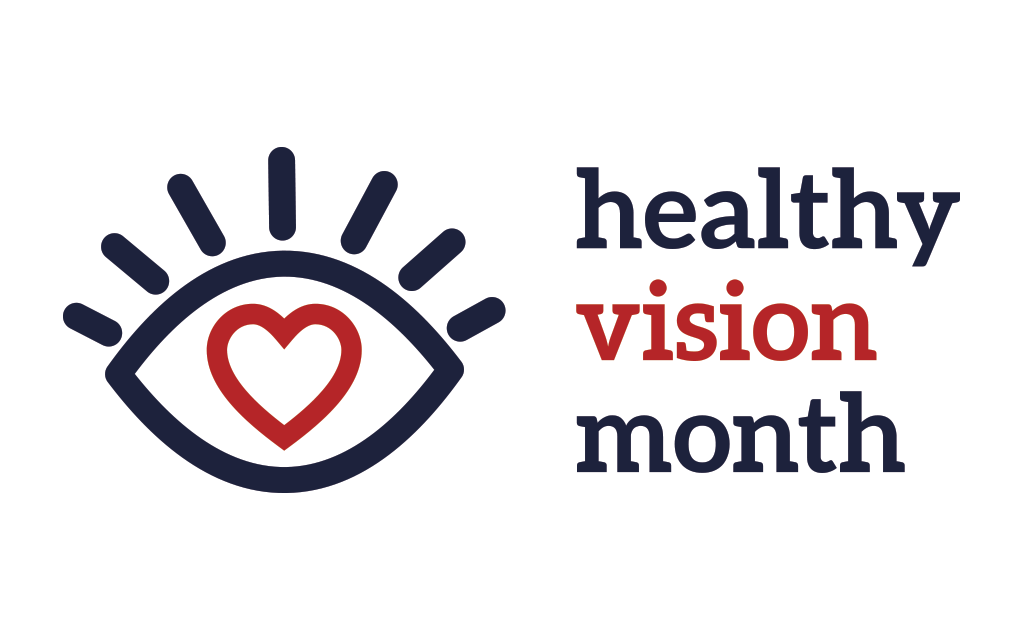
We go to the doctor or nurse regularly to make sure our bodies are healthy, so why don’t we do the same for our eyes? In a recent Harris Poll commissioned by the American Academy of Ophthalmology, 64 percent of adults had at least one issue with their vision, but only 13 percent said they had been seen by an ophthalmologist. While we may not think about the health of our eyes as much as we do about the health of our bodies, healthy eyes are just as important as a healthy body. Held every May, Healthy Vision Month is an annual event that brings awareness to healthy eyes.
About 80 percent of all vision impairment globally is avoidable, according to the World Health Organization. The leading causes of vision impairment are refractive errors, such as nearsightedness and farsightedness, cataracts, age-related macular degeneration (AMD), and glaucoma. Regular care from an eye care professional and steps to avoid eye injuries can help nearly everyone avoid these preventable eye problems.
The National Eye Institute (NEI) established Healthy Vision Awareness Month in 2003 to encourage all Americans to make healthy eyes a priority. Each year, the NEI and others host events to increase awareness of eye health and to provide valuable information about steps everyone can take to protect their vision.
Steps to Healthier Vision during May and the Rest of the Year
Take these steps to celebrate Healthy Vision Month this May and enjoy the benefits of clear vision throughout your lifetime. Give the gift of healthy vision by sharing these tips with your family, friends, co-workers and teammates.
Steps to healthy vision include:
Scheduling an eye exam
A comprehensive dilated eye exam can detect glaucoma, diabetic eye disease and other common eye diseases early, while they are most responsive to treatment.
Eating a healthy diet
Eating a healthy diet can reduce the risk of many eye disorders. Leafy green vegetables, such as spinach, kale and collards, contain lutein and zeaxanthin that can reduce the risk of age-related sight loss. Oily fish, such as tuna and salmon, contain omega-3 fatty acids that are essential for eye health.
Maintaining a healthy weight
Being overweight or obese increases the risk of diabetes and other health conditions that contribute to vision loss. For example, diabetes can lead to a diabetic retinopathy, which is a leading cause of blindness in working-age adults. Obesity is also associated with AMD, glaucoma and other eye diseases.
Not smoking
Smoking increases the risk of AMD, cataracts, and optic nerve damage that can all lead to vision loss and blindness.
Managing other health conditions
Many health conditions, such as diabetes, can affect the eyes. Keeping blood sugar levels under control can help people with diabetes reduce their risk of diabetic retinopathy.
Knowing your family history
Genetics seem to play a role in the development of glaucoma, AMD and many other eye diseases. Being aware of your family history can help you predict your risk for specific eye conditions, and inspire you to watch for signs that you are developing vision problems. Knowing your family history can also help you alert future generations to their potential risk of eye problems.
Using protective eyewear
Protective eyewear can prevent sports- and work-related eye injuries. More than 20,000 eye injuries occur in the workplace each year, and another 100,000 experience an eye injury while playing sports. Wearing protective eyewear can prevent more than 90 percent of serious work- and sports-related eye injuries.
Wearing sunglasses
Wearing sunglasses to protect the eyes from exposure to ultraviolet (UV) rays – even on cloudy days – as exposure to these rays can cause cataracts, macular degeneration, and other eye problems. Choose sunglasses that block out 99 to 100 of ultraviolet A (UVA) and ultraviolet B (UVB) rays.
Giving your eyes a rest
Working at a computer all day, or staring at a screen all evening, can cause digital eyestrain. Use the 20-20-20 rule to ease symptoms: every 20 minutes, look away from your screen and focus on something 20 feet away for 20 seconds.
Get plenty of physical activity
Any exercise that gets your heart pumping is good for your eyes, according to the NEI. Regular physical activity can also help you maintain a healthy weight.
For more information about Healthy Vision Awareness Month, or to find out if your eyes are healthy, consult with your eye doctor. Learning about healthy vision, and becoming aware of ways to protect your eyes, can help you see clearly for a lifetime.
Meta Title
Learn About Vision During Healthy Vision Month
Meta Description
Healthy Vision Month is a time to learn about conditions affecting vision and how to reduce the risk of vision loss
Sources
https://www.aao.org/newsroom/news-releases/detail/making-eyes-part-of-healthy-strategy
https://www.who.int/news-room/fact-sheets/detail/blindness-and-visual-impairment
https://nei.nih.gov/hvm/healthy_eyes_glasses
https://www.medicalnewstoday.com/articles/321226.php
https://nei.nih.gov/health/diabetic/retinopathy
https://opto.ca/health-library/the-link-between-obesity-and-eye-health
https://www.glaucoma.org/glaucoma/the-genetics-of-glaucoma-what-is-new.php
https://www.brightfocus.org/macular/question/age-related-macular-amd-hereditary
https://www.aao.org/eye-health/tips-prevention/injuries-work
https://www.aao.org/eye-health/tips-prevention/sports-eye-injuries-infographic-3

